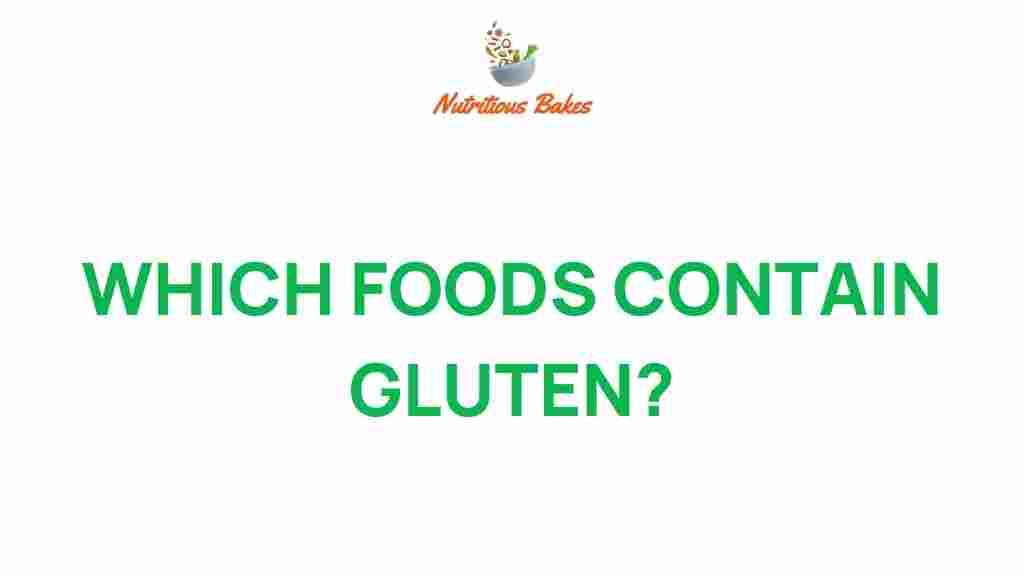Unmasking Gluten: What Foods Are Hiding This Common Ingredient?
In recent years, awareness surrounding gluten has grown significantly, leading many individuals to adopt gluten-free diets. But what exactly is gluten, and why has it become a focal point in discussions about health and nutrition? This article will delve into gluten, the foods that may be harboring it, and practical tips for those navigating dietary restrictions.
Understanding Gluten
Gluten is a protein found primarily in wheat, barley, and rye. It acts as a binding agent that helps foods maintain their shape and provides elasticity. For those with gluten sensitivities or disorders like celiac disease, consuming gluten can lead to serious health issues. Thus, understanding where gluten lurks in our food is crucial for maintaining health and wellness.
Why Go Gluten-Free?
Many people choose a gluten-free diet for various reasons, including:
- Health conditions like celiac disease, gluten sensitivity, or wheat allergy.
- Desire to improve overall health and wellness.
- Increased awareness of food labeling and nutritional content.
Identifying Hidden Sources of Gluten
When embarking on a gluten-free journey, it is vital to recognize foods that may contain hidden gluten. Below is a comprehensive list of common food categories and items to watch out for:
1. Baked Goods
This category often includes:
- Breads
- Cakes
- Cookies
- Pastries
Many baked goods are made with wheat flour, but some may also have hidden ingredients that contain gluten, such as malt vinegar.
2. Processed Foods
Processed foods can be a hidden source of gluten. Common items include:
- Condiments (e.g., soy sauce, salad dressings)
- Snack foods (e.g., chips, crackers)
- Ready-made meals
Always check food labeling for potential gluten-containing ingredients.
3. Grains and Cereals
Many grains are sources of gluten, including:
- Wheat
- Barley
- Rye
Even some oats can be contaminated with gluten during processing, so look for certified gluten-free oats.
4. Beverages
Some beverages may contain gluten, such as:
- Beer (which is made from barley)
- Some flavored coffees or teas
Always verify the labels and opt for gluten-free beer or other beverages.
5. Sauces and Soups
Many sauces and soups may contain gluten as a thickening agent or flavor enhancer. Common culprits include:
- Gravy
- Soups (especially those made with barley)
- Marinades
Be sure to check food labeling for gluten or wheat-based ingredients.
Deciphering Food Labeling
Understanding food labeling is essential for anyone avoiding gluten. Here’s a quick guide:
- Gluten-Free Label: Foods labeled as gluten-free must meet strict FDA guidelines. These items contain less than 20 parts per million (ppm) of gluten.
- Wheat-Free: This label does not necessarily mean the product is gluten-free, as it may still contain barley or rye.
- Cross-Contamination: Products made in the same facility as gluten-containing items may pose a risk of contamination.
For more in-depth information about food labeling regulations, visit the FDA’s official page.
Step-by-Step Guide to Going Gluten-Free
Transitioning to a gluten-free diet can seem daunting, but following these steps can make the process smoother:
Step 1: Educate Yourself
Learn about gluten and its sources. Familiarize yourself with the various names that gluten can hide under on ingredient lists, such as:
- Bulgur
- Semolina
- Spelt
Step 2: Clean Out Your Pantry
Remove all items containing gluten from your pantry. This includes checking labels and getting rid of:
- Wheat products
- Processed foods with hidden gluten
Step 3: Stock Up on Gluten-Free Alternatives
Replace gluten-containing items with gluten-free options. Consider stocking:
- Gluten-free grains (e.g., quinoa, rice, gluten-free oats)
- Almond flour or coconut flour for baking
- Gluten-free snacks and condiments
Step 4: Plan Your Meals
Planning meals in advance can help you avoid accidental gluten consumption. Focus on whole foods like:
- Fruits and vegetables
- Lean meats and fish
- Nuts and seeds
Step 5: Learn to Read Labels
Become proficient at reading food labels. Always check for gluten-free certifications and look out for hidden ingredients.
Troubleshooting Common Issues
While transitioning to a gluten-free diet, you may encounter challenges. Here are some troubleshooting tips:
Feeling Unwell After Going Gluten-Free
If you are feeling unwell despite adhering to a gluten-free diet, consider the following:
- Check for hidden sources of gluten in processed foods.
- Evaluate whether other dietary restrictions may be affecting your health.
- Consult with a healthcare provider or nutritionist for personalized advice.
Social Situations
Dining out or attending social gatherings can be tricky. Here are some strategies:
- Inform your host about your dietary restrictions in advance.
- Research restaurants with gluten-free menus.
- Bring your own gluten-free dish to share.
Dealing with Cravings
Cravings for gluten-containing foods are common. To manage this:
- Experiment with gluten-free recipes that mimic your favorite dishes.
- Find gluten-free snacks to satisfy cravings.
Conclusion
Unmasking gluten is essential for anyone with dietary restrictions. By understanding where gluten hides and how to navigate food labeling, you can make informed choices and maintain a healthy, gluten-free lifestyle. Always prioritize health awareness and nutrition while enjoying delicious alternatives. For further reading on gluten-free living, consider exploring resources from health organizations or speaking with a registered dietitian.
Ready to take the plunge into gluten-free living? Start today by checking your pantry and making a plan! Your health will thank you.
This article is in the category Diet and created by NutritiousBakes Team
